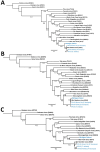Case of Human Orthohantavirus Infection, Michigan, USA, 2021
- PMID: 38526320
- PMCID: PMC10977823
- DOI: 10.3201/eid3004.231138
Case of Human Orthohantavirus Infection, Michigan, USA, 2021
Abstract
Orthohantaviruses cause hantavirus cardiopulmonary syndrome; most cases occur in the southwest region of the United States. We discuss a clinical case of orthohantavirus infection in a 65-year-old woman in Michigan and the phylogeographic link of partial viral fragments from the patient and rodents captured near the presumed site of infection.
Keywords: Michigan; New York virus; Orthohantavirus; Sin Nombre virus; United States; bunyavirdiae; genetics; infection; reservoir; transmission; viruses; zoonoses.
Figures

References
-
- Akram SM, Mangat R, Huang B. Hantavirus cardiopulmonary syndrome. In: StatPearls [Internet]. Treasure Island (FL): StatPearls Publishing; 2024. - PubMed
-
- Hjelle B, Lee SW, Song W, Torrez-Martinez N, Song JW, Yanagihara R, et al. Molecular linkage of hantavirus pulmonary syndrome to the white-footed mouse, Peromyscus leucopus: genetic characterization of the M genome of New York virus. J Virol. 1995;69:8137–41. 10.1128/jvi.69.12.8137-8141.1995 - DOI - PMC - PubMed
Publication types
MeSH terms
Grants and funding
LinkOut - more resources
Full Text Sources
Medical

